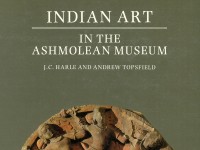Indian Art in the Ashmolean Museum
A catalogue of the Ashmolean’s collection of Indian art by J. C. Harle and Andrew Topsfield (published Oxford, 1987).

Publications online: 143 objects
- Reference URL
Actions
Figure of Shiva and Parvati (Uma-Maheshvara)
-
Literature notes
This is probably the archetypal icon of the later Hindu period in North India and parts of the Deccan. Śiva (Maheśvara, the “great god”) sits in lalitāsana (the same pose as in [EA1971.14 and EA1965.161], with Umā (another name for Pārvatī, Śiva’s śakti or divine Power), seated on his left thigh, her right arm thrown around the neck of the god; in the other hand she holds a mirror.
Śiva, with his unusually tall jaṭā-mukuṭa (the crown entwined with the matted hair of the ascetic and adorned with the crescent moon), is four-armed. His two upper hands hold the trident and a tricephalous serpent, his lower left clasps Umā around the waist, while his lower right in vyākhyāna-mudrā, the gesture signifying spiritual instruction, is placed near her right breast. Below are the usual assemblage: Śiva’s offspring, Gaṇeśa and Skanda (Kārttikeya), the latter barely indicated by a crude little peacock’s head, Nandī the bull and Bhṛṅgi, the skeletal ascetic, in a dancing pose. The lion, rarely represented in this icon, is Umā’s vehicle.
Above, under a pair of flying celestial beings bearing garlands, sit two deities, whose emblems and implements are difficult to discern, but they most likely are Brahmā, because of his paunch, on the proper right, and Viṣṇu on the left. -
Details
- Associated place
-
Asia › India › central India › Madhya Pradesh (place of creation)
- Date
- 1st half of the 11th century
- Material and technique
- sandstone
- Dimensions
- 60 x 42 x 17 cm max. (height x width x depth)
- Material index
- Technique index
- Object type index
- No. of items
- 1
- Credit line
- Presented by Sir Sourindro Mohun Tagore.
- Accession no.
- EAOS.70
-
Further reading
Harle, J. C., and Andrew Topsfield, Indian Art in the Ashmolean Museum (Oxford: Ashmolean Museum, 1987), no. 45 on p. 37, pp. xi, 35, 46, 48, & 49, illus. p. 37
Location
Objects are sometimes moved to a different location. Our object location data is usually updated on a monthly basis. Contact the Jameel Study Centre if you are planning to visit the museum to see a particular object on display, or would like to arrange an appointment to see an object in our reserve collections.
Publications online
-

Indian Art in the Ashmolean Museum
This is probably the archetypal icon of the later Hindu period in North India and parts of the Deccan. Śiva (Maheśvara, the “great god”) sits in lalitāsana (the same pose as in [EA1971.14 and EA1965.161], with Umā (another name for Pārvatī, Śiva’s śakti or divine Power), seated on his left thigh, her right arm thrown around the neck of the god; in the other hand she holds a mirror.
Śiva, with his unusually tall jaṭā-mukuṭa (the crown entwined with the matted hair of the ascetic and adorned with the crescent moon), is four-armed. His two upper hands hold the trident and a tricephalous serpent, his lower left clasps Umā around the waist, while his lower right in vyākhyāna-mudrā, the gesture signifying spiritual instruction, is placed near her right breast. Below are the usual assemblage: Śiva’s offspring, Gaṇeśa and Skanda (Kārttikeya), the latter barely indicated by a crude little peacock’s head, Nandī the bull and Bhṛṅgi, the skeletal ascetic, in a dancing pose. The lion, rarely represented in this icon, is Umā’s vehicle.
Above, under a pair of flying celestial beings bearing garlands, sit two deities, whose emblems and implements are difficult to discern, but they most likely are Brahmā, because of his paunch, on the proper right, and Viṣṇu on the left. -

Indian Art in the Ashmolean Museum
This is probably the archetypal icon of the later Hindu period in North India and parts of the Deccan. Śiva (Maheśvara, the “great god”) sits in lalitāsana (the same pose as in [EA1971.14 and EA1965.161], with Umā (another name for Pārvatī, Śiva’s śakti or divine Power), seated on his left thigh, her right arm thrown around the neck of the god; in the other hand she holds a mirror.
Śiva, with his unusually tall jaṭā-mukuṭa (the crown entwined with the matted hair of the ascetic and adorned with the crescent moon), is four-armed. His two upper hands hold the trident and a tricephalous serpent, his lower left clasps Umā around the waist, while his lower right in vyākhyāna-mudrā, the gesture signifying spiritual instruction, is placed near her right breast. Below are the usual assemblage: Śiva’s offspring, Gaṇeśa and Skanda (Kārttikeya), the latter barely indicated by a crude little peacock’s head, Nandī the bull and Bhṛṅgi, the skeletal ascetic, in a dancing pose. The lion, rarely represented in this icon, is Umā’s vehicle.
Above, under a pair of flying celestial beings bearing garlands, sit two deities, whose emblems and implements are difficult to discern, but they most likely are Brahmā, because of his paunch, on the proper right, and Viṣṇu on the left.
Galleries
Notice
Object information may not accurately reflect the actual contents of the original publication, since our online objects contain current information held in our collections database. Click on 'buy this publication' to purchase printed versions of our online publications, where available, or contact the Jameel Study Centre to arrange access to books on our collections that are now out of print.
© 2013 University of Oxford - Ashmolean Museum



